It starts with the bedding of Injera on a big plate. You dress different stews on the injera, then you gather everyone and bring out the scrumptious-looking plate for a big communal meal. How great is Ethiopian food? The flavor, spice, variety, and most importantly the sense of community.
Most Ethiopian meals have a base of onions, berbere, garlic, and tomatoes. Berbere is the name of the type of pepper that is used to prepare the berbere. The pepper is first dried and a mix of herbs and spices is dried. It is all then ground to make berbere. In this article, we’ll be diving into the rich and varied Ethiopian food, looking at the different meals present in the country, as well as their preparation.
Before that, almost all Ethiopians love to eat injera. So let’s start from that.
Injera – Gluten-free flatbreat
Injera, pronounced ‘n-je-rah, is the backbone of Ethiopian food. Whether you are in the rural side of the country or in the cities there is no escaping it. Injera is made from a round grain endemic to Ethiopia called teff, the latter is then ground into flour and mixed with water and ersho (powdered yeast) to make the batter. The batter is then rested for 2-3 days.
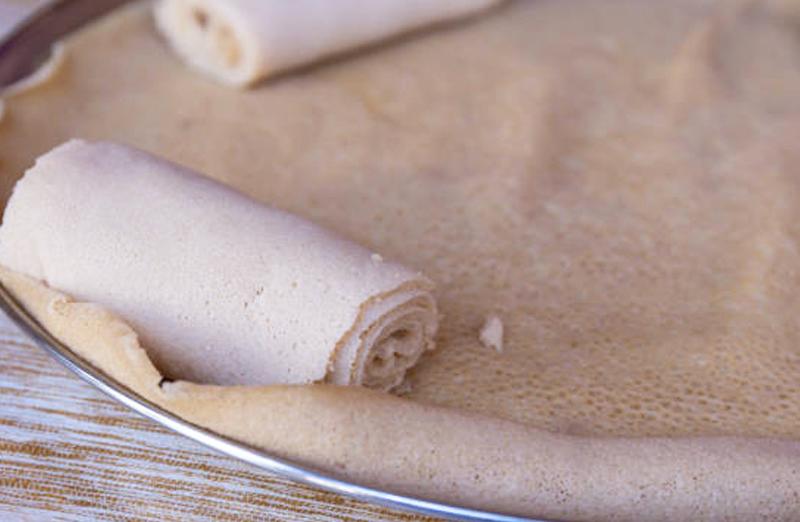
Injera preparation usually takes about 2-3 days due to the need for the batter to ferment. On the second or third day, a pot of water is boiled and one cup of the batter is mixed into the boiling pot of water. The mixture of the batter is then poured into the initially fermented batter and mixed. Heat the claypan also known as mitad. Thinly coat the pan in a circular pattern in batches. Cover the pan for 30 seconds and remove the injera. Repeat until there is enough batter for two more injeras. The leftover is used to make another batch of batter to be prepared in three days.
Related Topics
See the video to know how injera is prepared.
Although injera is eaten throughout the country, there are other types of food to consider in the rich cultures present in Ethiopia. Let’s see special occasion Ethiopian food in the next chapter.
Ethiopian Food and Special Occasions
Spice and variety are core elements in Ethiopian food. This is no different for food during special occasions. Holidays and special occasions are a big deal, it’s a time for close family and extended ones to come together, dance, drink and eat food. We have Doro Wot, Kitfo, Difo Dabo, Gomen be Siga, and raw meat among these foods. These foods are looked forward to by Ethiopians since they are rarely made and are occasional foods.
Doro Wot
Doro wot is a spicy chicken stew. Preparing the food is a time to bond between matriarchs and their daughters. Not only is it a time for mothers and daughters to bond but a time for fathers and sons to bond as well. The father figure of the house usually slays the chicken. The making of Doro wot is traditional and family recipes are passed down during the lengthy process.

How to make Doro Wot Stew
Kitfo
As previously discussed, Kitfo originates from the Gurage region of Ethiopia. It can be eaten raw, medium-rare, or well-done. It is traditionally served on a big platter with a leaf of the false banana tree. Kitfo is prepared by marinating raw minced meat with a powdered chili and spice blend called mitmita, and kibe. The meat can be cooked as per the person’s preference. The marinated raw or cooked with is then plated accompanied by ayibe, kocho, gomen, and injera can either be eaten by using your hands or using a long spoon, as per your preferences. Ayibe is a goat cheese type of mild cheese, eaten mixed with minced collard greens, or mitmita.
How to make kitfo
Difo Dabo
Difo dabo is a holiday and special occasion favorite. It is one of the many breads prepared in Ethiopia. Traditionally and in most rural areas of Ethiopia, difo dabo is prepared by using traditional baking methods over a burning wood fire. However, difo dabo can be made with an oven by wrapping the dough in fake banana leaf or enset leaf and placing it in the oven. The recipe consists of flour, salt, cumin seed, caraway seed, dry yeast, and sugar. The batter is then left to rise in the banana leaf and once risen baked for 45 to 60 minutes.
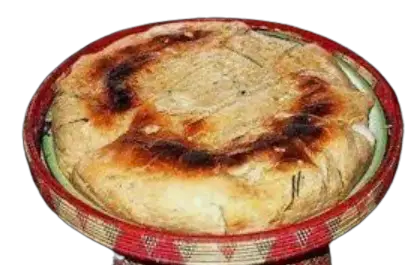
Watch the video on How to make Difo Dabo
Gomen be Siga
Loosely translated to collard greens with meat. Gomen be Siga is cooked with collard greens, chunks of beef meat, kibe (clarified butter), onions, and garlic. Some recipes also include mitmita in the preparation of gomen be siga. Like most of the foods in this article, gomen be siga is often eaten paired with injera.
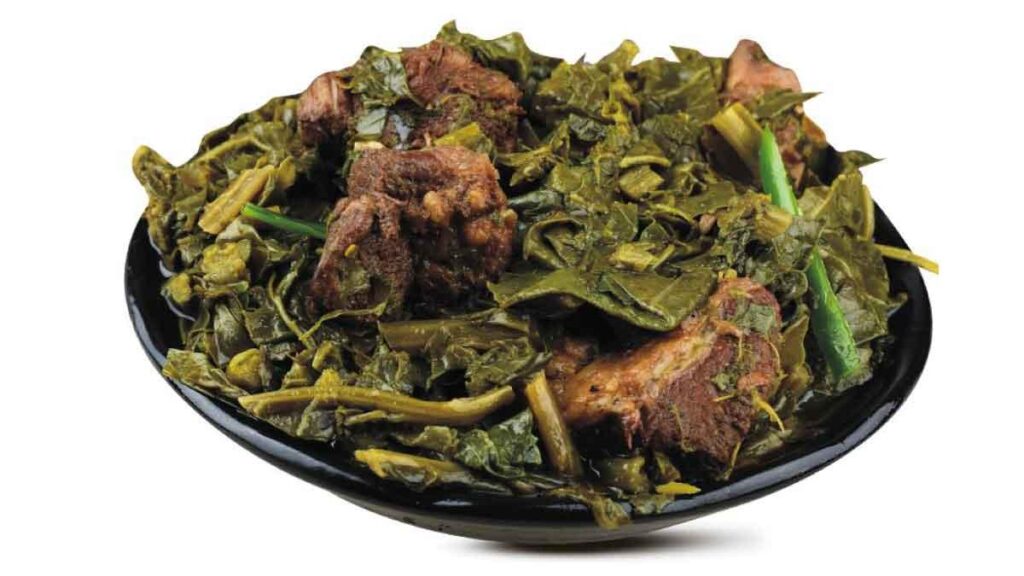
Raw Meat
Raw meat is a delicacy. Legend has it that soldiers started eating raw meat as a military tactic. Soldiers hiding in mountainous areas stopped from starting fires not to let enemies their locations. Raw meat also referred to as tire siga, has come far from where it originally started. Butcheries in Ethiopia are packed during weekends and pre and post fasting seasons with consumers craving raw meat. This delicacy can be eaten dipped in Ethiopian hot sauce (awaze), Ethiopian mustard (senafech), or with mitmita, along with injera or bread.
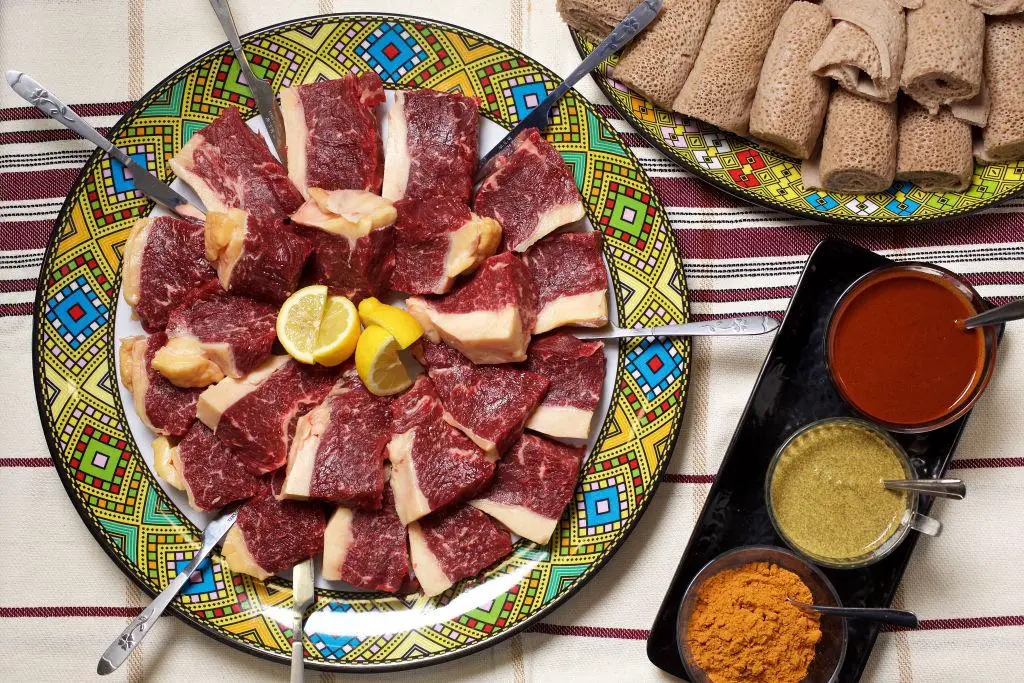
How Ethiopians eat Raw Meat
Regional Ethiopian Food
Apart from the special occasion foods mentioned above, Ethiopian food may vary from culture to culture. Especially in Tigray, Oromia and Gurage people have their own unique food culture. We will see those specific regions below.
Tigray
Let’s take a trip North and take a look at the Tigray region and foods specific to that region. When thinking about the Tigray region and food specific to it three foods come to mind: Ambasha, Hibist bread, and Tihelo. Injera is still a core component of the food in Tigray. These four foods are very specific to that region.
Ambasha and Hibist
Even though Ambasha also referred to as Himbasha can be found in a lot of Ethiopian households. Ambasha originates from the Tigray region. Hibist bread is a soft type of bread. It is prepared by steam-baking the dough. Both Ambasha and Hibist are traditionally prepared by fermenting wheat flour.
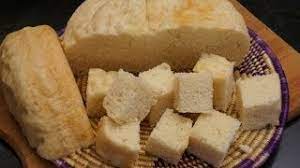
Tihelo
Tihelo eaten with a wooden spoon referred to as shenter is a traditional meal in the Tigray region. Normally prepared and served by women. The meal is blessed and eating begins with the woman having prepared it taking the first bite. Prepared by making a barley flour dough. The dough is then incubated in warm water, dried for 12 hours, and toasted. Tihelo is served by pinching the dough alongside a tomato or meat sauce.
Oromia
The Oromo region accounts for 35% of the population in Ethiopia. This being said, however, they have had little influence on the food in Ethiopia. Yet there are staple foods in the Oromo region that are craved and eaten by everyone in the country. When thinking about food in the Oromia region, some key foods are chuko/marqaa, chororsa, and baduu. It is key to state and highlight that most of the foods and recipes in Ethiopia are spice-infused and flavorful.
Oromo traditional recipes are almost dependent on mitmita and dairy, specifically ayibe and qibe (traditional cottage cheese and clarified butter). Chuko, for example, is a barely-preserved butter snack. Powdered barley is mixed with a lot of clarified butter along with onion, salt, ginger, and other spices. Depending on the recipe and the preference mitmita and sugar are also incorporated into the recipe.
On the other hand, we have chororsa and baduu concentrated on ayibe (traditional cottage cheese). Both of these foods are based on qibe, ayibe and mitmita, the ayibe balances out the spiciness of the meal and makes it a delicious meal.
Gurage
The Gurage people are known for various things from food to clothing to dancing; they have a rich and abundant culture. Among these cultures, one that stands out is the food culture.
Kitfo is a mix of minced raw meat, clarified butter and mitmita and is eaten with kocho. The latter is prepared from a plant called enset or false banana tree and makes for flatbread. It is prepared by covering the enset in the false banana tree leaf and putting it on fire. Kitfo is also eaten with a side dish called ayibe and gomen kitfo, minced collard greens mixed with butter. The ayibe like the kitfo is mixed with butter and even mitmita. Kitfo is very special to many people throughout the country regardless if they have a Gurage background. The details on Kitfo will be discussed in the special occasions section of this article.
Day to Day Ethiopian Food
Stews, locally known as wot, and vegetable meals are a core to the Ethiopian diet, as injera is typically eaten. There are a variety of stews in the Ethiopian culture, eaten throughout the year. The food is divided into two categories: fast foods eaten during fasting and non-fasting foods typically eaten during non-fasting periods. This being said, it does not, however, mean that fasting foods are exclusively reserved for the fasting periods. The same goes for non-fasting foods.
Fasting Foods
The fasting periods are common in Ethiopia as a majority of the days during the Orthodox Calendar are fasting days (Almost 200 days a year). During the fasting seasons, dairy and meat products are not allowed for consumption in the Orthodox religion. Yet, there are a wide variety of meals and sauces made in these seasons that shame meat and meat-based sauces.
Shiro
One of the most adored and easily found sauces in Ethiopian cuisine is shiro. Many Ethiopians and non-Ethiopians love Shiro as it can be found in most Ethiopian households. Shiro has many variations, we’ll look into the different variations of Shiro in section.
Shiro wot is known or presented to most foreigners as chickpea stew. The chickpea is first dried and powdered. It can be powdered with or without berbere, the Shiro powdered with berbere is called miten Shiro. The basic recipe for Shiro wot requires onions and garlic, some recipes use berbere, tomatoes, and jalapeno as well as turmeric. Tumeric-based Shiro calls for a powdered Shiro without berbere and is called alecha Shiro. As you may have already guessed berbere and alecha can be used interchangeably with one another.
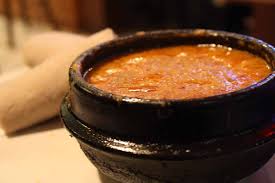
The third variation of Shiro is Shiro fitfit, The latter is prepared by mixing the powdered Shiro with water, salt, chopped onions, jalapeno peppers, and tomatoes. Shredded injera is then added to the mix and combined together. The fourth variation of Shiro is tegabino Shiro. The already prepared Shiro wot will be put into a clay pot that will be put on a stove/over a fire and removed from the fire once the Shiro is thicker and served bubbling. Lastly, we have Bozena Shiro, a type of Shiro made with bite-sized chunks of meat.
Misir Wot
Another typical food in Ethiopian cuisine is misir wot. Misir wot is a stew prepared using red lentils. Misir wot can be found during both fasting and non-fasting seasons. The only difference when eaten is that during the fasting season qibe and meat are not included in the recipe when eaten during the non-fasting seasons. Like Shiro, misir wot has different variations, such as a turmeric base misir wot called alicha misir wot, a berbere base misir wot which is the mainstream type of misir wot. And as aforementioned the non-fasting variations where qibe and meat are included.
Beyaynetu
If you want to try a variety of Ethiopian foods or want a burst of flavors with every bite you take in one meal this is the food for you. Beyaynetu translates into English as “of all types”, which is exactly what the meal is. You will have from 5 to 10 and even more different types of stews and vegetable dishes with this meal. A typical beyaynetu usually consists of misir wot both with turmeric base and berbere base, shiro wot, basic salad, turmeric potato curry with carrots (alecha dinich wot), stir-fried beetroot with potatoes, stir-fried carrots and green beans with salsa, and fried collard greens. It is key to note that beyaynetu is strictly a vegan meal and is eaten during fasting/Lent seasons. On the other hand, however, there is a non-fasting dish very similar to mehaberawi. Both are served on a big plate and a top of a spread out injera and shared with friends since in most cases, one person cannot
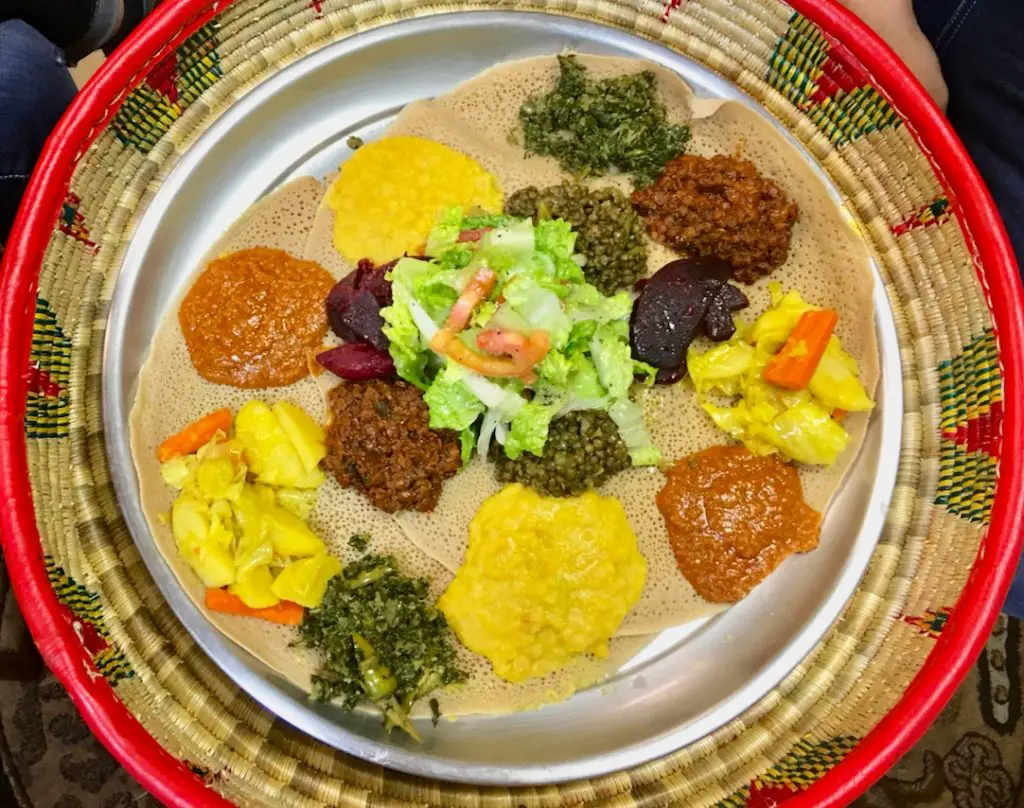
Non-Fasting Foods
As we’ve previously seen, there are two seasons and types of dishes in Ethiopian foods and recipes. Non-fasting Ethiopian Foods, as the name entails, are dishes that cannot be eaten during fasting seasons. These dishes are generally rich in dairy products and meat-based. The dairy is normally clarified butter or ayibe.
Siga Wot
Siga Wot is a meat-based stew and like all stews in Ethiopian food, it is eaten with Injera. The meat is first to cut into small chunks. Onions, tomatoes, and garlic are minced. You heat a pot over the fire, put in the onions, cook them until they are caramelized, and add the meat and cook until it’s brown. You then add berbere to the caramelized onions and chunks of beef and cook for about 10 minutes, stirring it every 1-2 minutes (s). Next, add the garlic and tomato and stir well until the tomatoes are dissolved. Add a few cups of water and cook until you have your preferred thickness. Lastly, and optionally, you can add in a few spoons of butter and add in your salt. Serve it with injera. Siga is found in many households, especially after the holiday seasons as there is usually an abundance of meat after holidays.
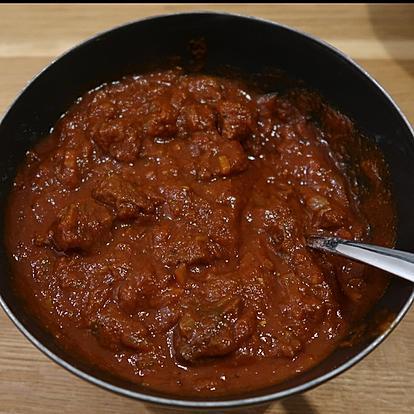
Tibs
If you’re craving an easy-make recipe with meat and all of the Ethiopian flavors, Tibs is definitely for you. Tibs is stir-fried lamb or beef with vegetables. These vegetables are the basic vegetables found in many Ethiopian recipes – tomatoes, onions, and jalapenos. The recipe is fundamental and the meal is very easy to make. The meat is first to cut into small bite-sized chunks. A pan is heated until it’s very hot. The meat is put onto the pan and cooked until brown, the meat can be cooked either with qibe or vegetable oil. Once the meat is brown, you can add your salt and pepper (or even awaze). Some recipes also include a teaspoon of garlic paste. And your meal is ready to serve. Tibs can be found in any restaurant and anywhere in the country.
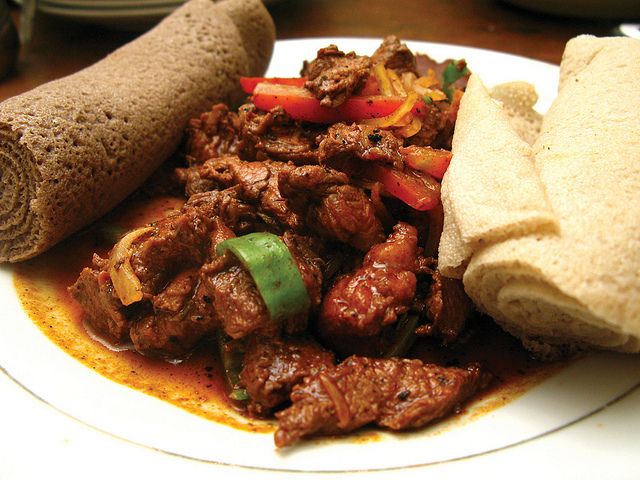
Qeqel
This dish is a mix of soup and stew, this is because it is more watery than a lot of the other dishes that are found in Ethiopian cuisine. Qeqel is packed in flavor and can either be eaten with injera as a fitfit or drank alone just like a soup. The recipe calls for chunks of meat and bones with meat on them as well as minced onions and garlic, qibe and sliced jalapeno peppers. Some recipes also use potatoes to thicken the stew a little. There is no specific type of meat used for this recipe and meat such as goat meat, lamb, and beef can be used for this recipe. The dish is slow-cooked for at least one hour.
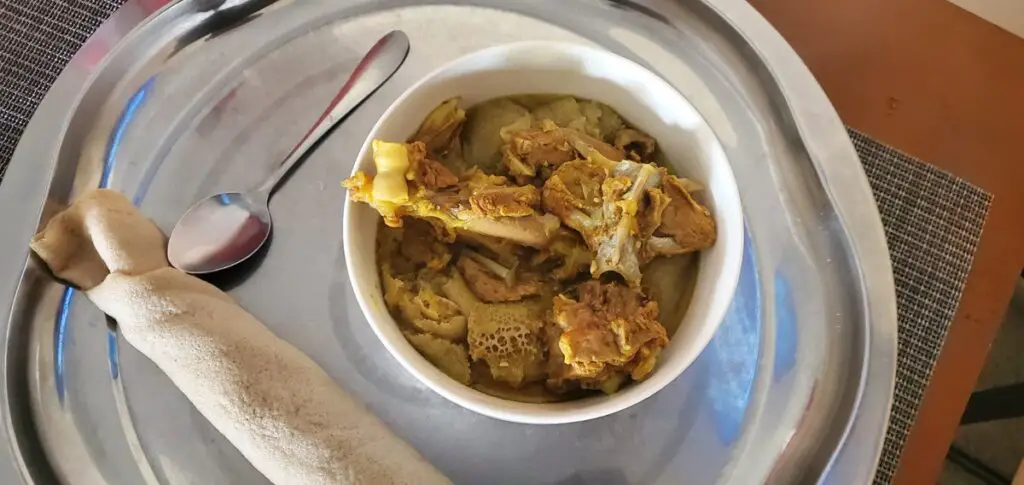
Ethiopian Drinks – Tej, Tella, and Areqe
If you’re looking to have a good time and drinks, whether strong, sour, or sweet, traditional Ethiopian drinks are your go-to drinks. Standard Ethiopian drinks are tella, tej, and areqe.
Tella
Tella, a beer-like drink, is often home-brewed and can be found in most Ethiopian households during holidays and parties. If you go into the rural areas of the country tella like Injera is a staple and available in many households. It can also be found in small bar-like places called tella bet. Keep in mind that Tella has different names in different regions. In the Oromo region and language, it’s called farsoo, whereas in the Tigrai region, it is referred to as Siwa. With a smokey sour-esque flavor, Tella contains 2-6 vol% alcohol volume depending on the recipe and whether it is filtered or unfiltered.
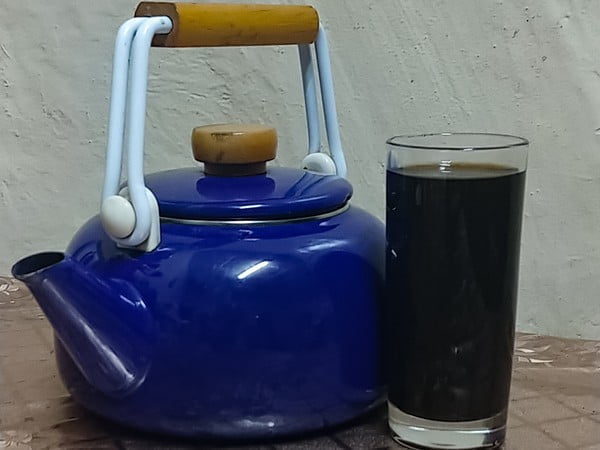
Tej
On the other hand, like tella, Tej is a home-brewed drink. Unlike Tella, however, Tej is an occasional drink for most Ethiopians, especially in today’s economy, as honey prices have increased. Tej is a sweet honey-based alcoholic drink with a 7-11% alcohol volume and can be equated to a sweet wine. Tej is often served in flask-like glass called berile. Tej is prepared by brewing together honey, water, and a shrub locally known as gesho. The combination is concealed in an air-tight container for two weeks until it is well fermented and ready for consumption. A berile of Tej is often served with the caution of pacing yourself, drinking slowly, and testing your legs now and again.

Areqe
Areqe, is the most potent form of alcohol in Ethiopia. Although Areqe is usually a clear, flavorless liquid, it can also come flavored. Areqe, like the other drinks, can be homemade. However, that is not the case in most cities. Presently, Areqe is made by the National Alcohol and Liquor Factory and dispensed throughout the country. People in rural communities of Ethiopia also make it. This drink is believed to have a shocking 70% alcohol volume and is often used to help with stomachaches.

Conclusion
If you are in Ethiopia, make sure to visit mother bets (house in Amharic), which are small food stalls found throughout the country, they are insanely affordable and packed with people. These spots are referred to as mother houses as the people serving them cook like they are cooking home-cooked meals and serve as family members. There you have it, the great spice and variety-filled Ethiopian cuisine. From the basics of injera to tradition to regional foods, the cuisine in Ethiopia is eclectic, varied, and beautifully addictive. It is truly an experience to cherish and love.
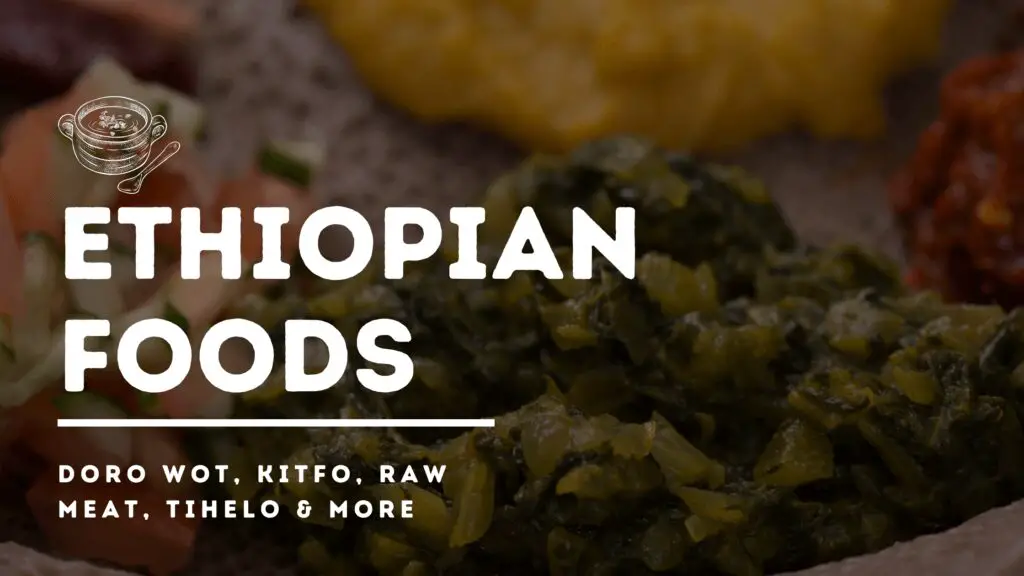


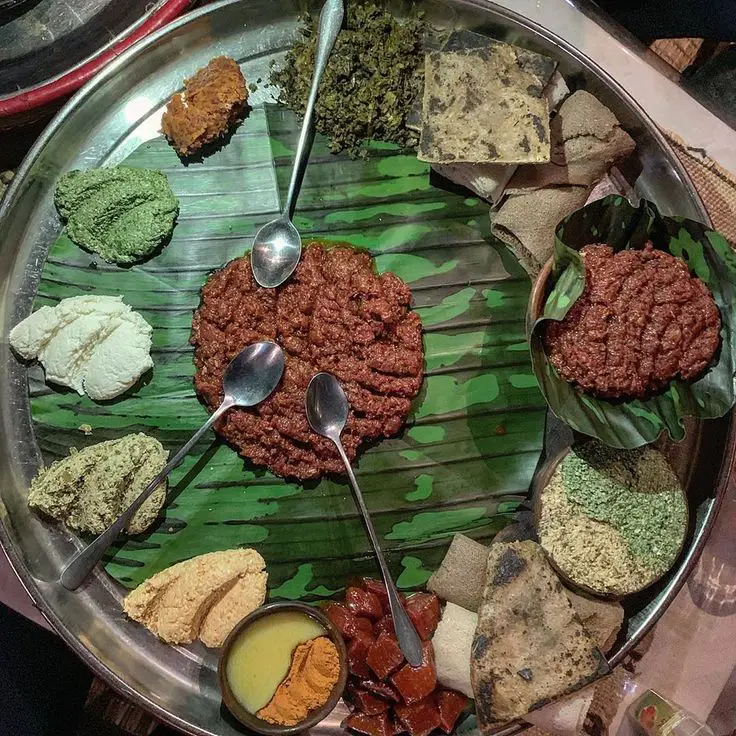
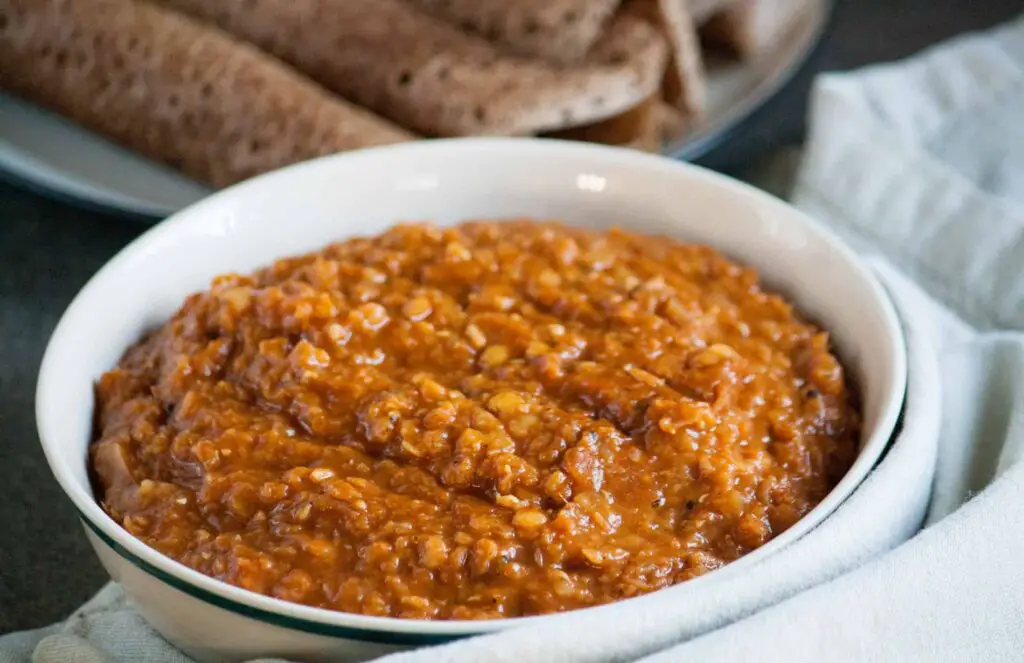







0 Comments